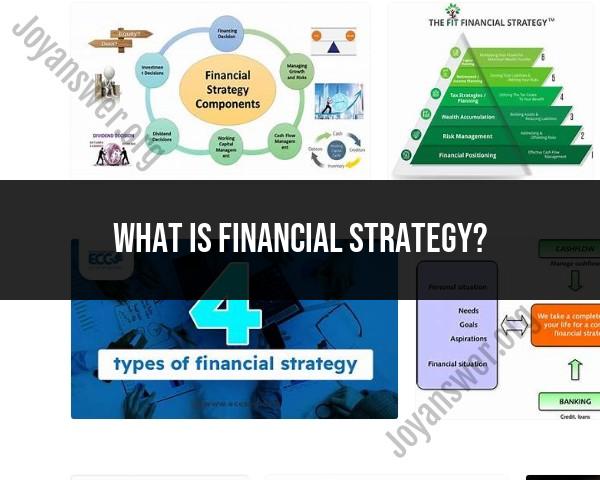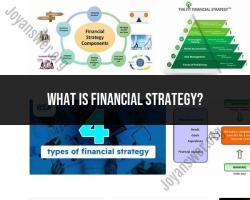What is financial strategy?
What Is Financial Strategy? Definition and Examples
What is Financial Strategy?
Financial strategy is a comprehensive plan that guides how a business manages its financial resources to achieve its overall goals. It involves setting priorities, allocating capital, managing risks, and making investment decisions that align with the company’s long-term vision.
In short, it’s the roadmap that connects financial management to business success.
Key Elements of Financial Strategy
Capital Planning: Deciding how much money is needed and where it should come from (debt, equity, or internal funds).
Investment Decisions: Choosing which projects, assets, or opportunities to fund.
Risk Management: Identifying financial risks (market, credit, liquidity) and mitigating them.
Profitability Goals: Setting targets for revenue growth, cost control, and return on investment.
Cash Flow Management: Ensuring enough liquidity to meet obligations and invest in growth.
Funding Structure: Balancing debt and equity to optimize the company’s cost of capital.
Why Is Financial Strategy Important?
Helps ensure resources are used efficiently.
Supports sustainable growth and competitiveness.
Aligns finance decisions with business strategy.
Prepares the company to handle economic changes and uncertainties.
Examples of Financial Strategy in Action
Growth through Acquisition: A company raises capital to buy competitors, increasing market share.
Cost Leadership: Tight cost controls and efficient capital use to offer lower prices than competitors.
Innovation Investment: Allocating funds to R&D to develop new products and stay ahead in technology.
Debt Management: Strategically reducing debt to improve credit rating and reduce interest costs.
Dividend Policy: Balancing between returning profits to shareholders and reinvesting in the business.
Summary
Financial strategy is the plan that ensures a company’s money decisions support its business goals — guiding everything from investments and funding to risk and profitability management.
A financial strategy is a comprehensive, long-term plan that outlines how a business will manage its financial resources to achieve its overall strategic goals and objectives.
What Is the Definition of Financial Strategy?
A financial strategy is a structured roadmap that aligns an organization's financial resources, capabilities, and decisions with its overarching long-term business objectives.
How Does Financial Strategy Support Business Goals?
Financial strategy is crucial because it directly supports and enables the achievement of broader business goals in several ways:
Resource Alignment: It ensures that financial resources (cash, investments, debt) are allocated efficiently to the most impactful initiatives that directly contribute to strategic objectives, whether that's expanding into new markets, developing new products, or improving operational efficiency.
Feasibility and Realism: It provides the financial reality check for strategic plans. By analyzing current financial health, forecasting future scenarios, and assessing capital availability, it determines if ambitious business goals are financially achievable and sustainable.
Informed Decision-Making: Financial strategy equips leaders with data-driven insights to make critical decisions. This includes evaluating mergers and acquisitions, significant capital investments, and long-term funding choices based on their potential financial impact and risk profile.
Risk Management: A robust financial strategy identifies potential financial vulnerabilities (e.g., market volatility, liquidity issues, credit risks) and outlines plans to mitigate them, safeguarding the company's financial stability during uncertain times.
Performance Measurement: It establishes clear financial goals and Key Performance Indicators (KPIs) that allow the organization to track progress, measure the success of strategic initiatives, and make necessary adjustments.
Enhancing Shareholder Value: Ultimately, a well-executed financial strategy aims to optimize profitability, manage costs, and make smart investments that increase the company's value for its shareholders over time.
What Are Key Components of a Successful Financial Strategy?
A successful financial strategy is built upon several interconnected components:
Clear Financial Goals: Setting specific, measurable, achievable, relevant, and time-bound (SMART) financial objectives that directly support the overall business strategy.
Examples include target revenue growth, profit margins, debt-to-equity ratios, or return on investment (ROI). Comprehensive Financial Analysis: A thorough assessment of the company's current financial health, including income statements, balance sheets, cash flow statements, and key financial ratios.
This analysis reveals strengths, weaknesses, risks, and opportunities. Capital Structure Management: Determining the optimal mix of debt and equity financing to fund operations and growth initiatives.
This involves evaluating borrowing costs, risk tolerance, and the impact on shareholder value. Investment Strategy: A roadmap for where, when, and how much to invest.
This includes decisions on capital expenditures (e.g., new equipment, facilities), research and development, marketing, and potential mergers or acquisitions, all aimed at maximizing long-term returns. Budgeting and Expense Management: Creating detailed financial blueprints that align resource allocation with strategic priorities, controlling costs, identifying efficiencies, and ensuring funds are used effectively.
Cash Flow Management: Strategies to ensure sufficient liquidity to meet short-term obligations and fund operations, often involving forecasting, managing receivables and payables, and establishing lines of credit.
Risk Management: Identifying, assessing, and developing strategies to mitigate financial risks (e.g., market risk, credit risk, operational risk, regulatory compliance).
This includes contingency planning for various scenarios. Performance Monitoring and Adjustment: Continuously tracking financial metrics against set goals, conducting regular reviews, and making timely adjustments to the strategy in response to changing market conditions or internal performance.
How Is Financial Strategy Different from Financial Planning?
While often used interchangeably, financial strategy and financial planning are distinct yet complementary concepts:
Financial Strategy (The "Why" and "What"): This is the broader, high-level approach that defines the long-term financial direction and overarching objectives.
It's about why certain financial decisions are being made and what ultimate financial goals the company aims to achieve (e.g., "to become the market leader in sustainable manufacturing by optimizing capital allocation for green technologies"). It's more conceptual and sets the guiding principles. Financial Planning (The "How" and "When"): This is the detailed, operational process of outlining how to execute the financial strategy. It's about how financial resources will be managed day-to-day, month-to-month, or year-to-year, and when specific financial activities will occur. This involves specific budgets, forecasts, cash flow statements, and detailed investment schedules. It's the practical implementation arm of the strategy.
Think of it like building a house:
Financial Strategy is the architect's vision for the house: its overall style, purpose, desired size, and long-term functionality (e.g., "a modern, energy-efficient family home").
Financial Planning is the engineer's detailed blueprints and construction schedule: the specific materials, budget for each phase, contractor timelines, and cash flow projections for the entire building process.
One informs the other: the strategy provides the direction, and the planning provides the actionable steps to get there.
Why Is Financial Strategy Important for Long-Term Growth?
Financial strategy is paramount for long-term growth because it provides the framework for sustainable and resilient expansion in a dynamic business environment.
Sustainable Growth: It ensures that growth initiatives are not just about short-term gains but are financially viable over the long haul.
This prevents overleveraging, inefficient spending, or expansion into unprofitable areas. Adaptive Capability: In a rapidly changing market, a well-defined financial strategy allows businesses to anticipate shifts, adapt quickly, and seize emerging opportunities without jeopardizing financial stability. It fosters agility.
Optimized Resource Utilization: Long-term growth requires smart allocation of finite resources.
Financial strategy helps direct capital towards the most promising investments, ensuring maximum return on every dollar invested in growth. Mitigation of Risks: Growth often comes with increased risks. A strategic financial approach allows for proactive identification and management of these risks, reducing the likelihood of financial crises that could derail long-term plans.
Competitive Advantage: Companies with robust financial strategies are better positioned to outmaneuver competitors. They can make timely investments, fund innovation, and weather economic downturns more effectively, leading to sustained market leadership.
Investor Confidence: A clear and well-executed financial strategy signals competence and foresight to investors and stakeholders, attracting necessary capital for future growth and ensuring continued support.













